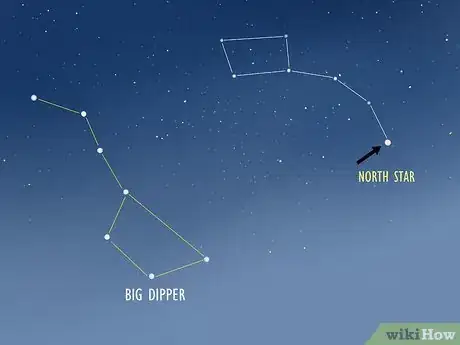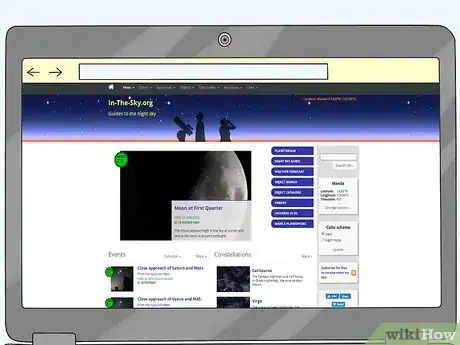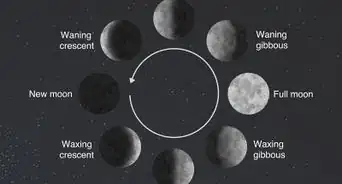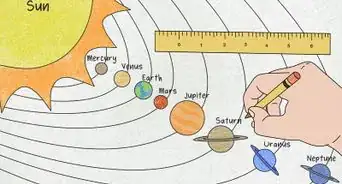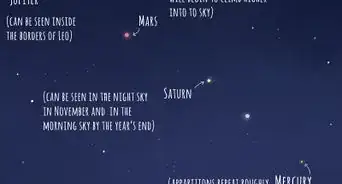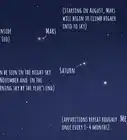This article was co-authored by wikiHow Staff. Our trained team of editors and researchers validate articles for accuracy and comprehensiveness. wikiHow's Content Management Team carefully monitors the work from our editorial staff to ensure that each article is backed by trusted research and meets our high quality standards.
There are 9 references cited in this article, which can be found at the bottom of the page.
This article has been viewed 57,009 times.
Learn more...
There are billions of stars in the night sky, and stargazing is a very popular and enjoyable pastime. Getting started identifying constellations and stars in the sky is easy. Most of the major stars, like Polaris or Alpha Centauri, are part of constellations, so learning the constellations will help you find those stars. You can also use charts, websites, and apps to help you identify stars and constellations. With these tools, you’ll get started as an amateur stargazer in no time.
Steps
Locating Major Stars with Constellations
-
1Find the North Star by locating the Big Dipper. The North Star, or Polaris, marks the North Pole and makes star navigation possible. Start by finding the Big Dipper, a large part of the Ursa Major constellation that looks like a pot. This is to the north. Follow the handle of the pot until it bends, and move your eyes to the opposite side from where the handle bends. This takes you to the Little Dipper. Follow the handle to the end to find the North Star.[1]
- You can only see the North Star if you’re in the Northern Hemisphere. If you’re in the Southern Hemisphere, you can navigate by finding the South Pole instead with the Southern Cross constellation.
- The Big Dipper is always visible if you're above 41 degrees north, which is above the northern half of the US. Below that, it sinks below the horizon and is only visible around dawn.
-
2Locate Alpha Centauri with the Centaurus constellation. Alpha Centauri is the closest star to Earth, so it’s exciting to locate. In the Southern Hemisphere, start by finding the Southern Cross constellation, a collection of 4 bright stars that make a distinctive cross marking the South Pole. As the name suggests, it's in the south. Draw an imaginary line connecting the 2 stars that are a shorter distance apart. Continue that line out from the brighter star of the 2, and stop when you come across another large, bright star on the side of the Southern Cross. This is Alpha Centauri.[2]
- Alpha Centauri is very far south in the night sky, so it’s invisible from most parts of the Northern Hemisphere. You could spot it sometimes in early May, however, if you live near the equator.
Advertisement -
3Use the Orion constellation to find Sirius. The Orion constellation appears slightly south if you're in the Northern Hemisphere and high to the north if you're in the Southern Hemisphere. It's easy to locate by finding the 3 medium-brightness stars that make a straight line, forming the constellation’s belt. Find the bow section of the constellation by locating the 4 stars that make a curved line. Then, trace a straight line down from the side of Orion’s belt opposite from the bow to find Sirius.[3]
- Sirius is the brightest star in the night sky, so you may not even need to use constellations to find it.
- Orion is easy to locate because it’s bright at all times. Even if you live in a city with a lot of light pollution, you should have no trouble finding it. It's highest in the sky in the winter, but you can also find it lower near the horizon in the summer months.
-
4Look straight down from Sirius to find Canopus. Canopus is the second brightest star in the night sky, and it’s easy to find once you locate Sirius. Imagine a line extending straight down from Sirius. Just right of that line, slightly above the horizon, is Canopus.[4]
- Canopus has a slightly red tint because it’s close to the horizon.
-
5Spot Rigel in the lower right side of Orion. Rigel is another one of the brightest stars in the night sky, and the brightest in the Orion constellation. Once you locate Orion, look down and to the right of Orion's belt. This is where Orion's right foot would be, and it's where Rigel sits in the constellation.[5]
- Rigel also has a slightly blue-purple tint, making it easier to spot within Orion.
- Rigel is fun to identify because many science fiction movies and shows, like Star Trek, use that name for places or characters.
-
6Find Vega with the Lyra constellation. Vega is a bright blue star that forms the base of the Lyra constellation. Lyra is almost always straight up in the night sky if you’re in the Northern Hemisphere, but it's most visible to the north in the summer months. 4 stars make a box leading to a straight line for the base. The middle star on the base is Vega.[6]
- Vega is also very bright, so it’s possible to spot it without the constellation. Look north for its blue tint to help you locate it.
Using Charts and Apps
-
1Use a star chart to locate other stars and constellations. A star chart is a paper map of the night sky tailored to your hemisphere and the season. Some are adjustable, and you can slide the rim to match different times of year. Get a star chart for the current season that you’re in. Then orient the chart to the direction you’re looking and the time of day it is. Spin the outer rim of the chart to adjust it to the time of day. Hold it up to the sky when it’s oriented to map out the other stars and constellations.[7]
- There are star charts for the Northern and Southern Hemispheres. Make sure you get the right one for where you live.
- You can buy cheap star charts online. You can also print free ones off of some websites.
-
2Read star atlases to get more familiar with the night sky. Learning more about the stars will help you locate and identify more of them. You'll know which directions to look, what time of year is best for certain stars, and how to differentiate stars from planets. This is all valuable information for stargazing, so read as many books and atlases as you can to improve your skills.[8]
- Try to use resources from the National Parks Service, NASA, National Geographic, and Norton. All produce quality information and atlases.
- You can find most of these books at the library, so there's no need to spend a lot of money.
-
3Download stargazing apps to get interactive views of your night sky. Apps are helpful if you don’t have a paper star chart or prefer to use your phone instead. Search the app store for astronomy or stargazing apps to use at night. Look for one with a good star locator so your can identify different stars.[9]
- Stargazing apps range from basic star charts to programs that map the entire sky when you hold the phone up. Pick one that has features you want. If they’re free, try downloading a few and see which you like best.
- Some well-known free apps are StarChart and the NASA app. Other ones like SkySafari, Starmap, and Pocket Universe are more powerful, but cost a few dollars to download.
-
4Visit a star mapping website to plan your stargazing. Search for star mapping sites online and type in your location. These websites will then produce an image of what the night sky looks like above you. Use this chart to locate and identify the different stars that you’ll see in the night sky.[10]
- Popular websites are In-The-Sky.org, earthsky.org, and stargazing.net. The NASA and National Geographic websites also have good stargazing information and articles.
- Some websites let you print star maps after typing in all of your information. That way, you’ll have a physical copy to take with you when you go stargazing.
References
- ↑ https://www.universetoday.com/45775/famous-stars/
- ↑ https://www.constellation-guide.com/alpha-centauri/
- ↑ https://www.space.com/21702-sirius-brightest-star.html
- ↑ https://www.nao.ac.jp/en/astro/sky/2017/02-topics01.html
- ↑ https://www.universetoday.com/45775/famous-stars/
- ↑ https://www.space.com/27033-vega-star-harp-constellation-lyra.html
- ↑ http://www.astro.umass.edu/~arny/constel/constel_tutmod.html
- ↑ https://astronomy.com/observing/get-to-know-the-night-sky/2014/04/choose-a-star-atlas-thats-right-for-you
- ↑ https://www.space.com/best-stargazing-apps
